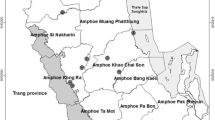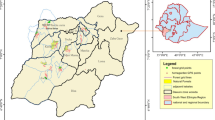Abstract
Communities in Cabo Delgado have a long tradition of using medicinal plants. In Mozambique, rural populations in general are highly dependent on natural resources. One example is the use of surrounding vegetation by people from Cabo Delgado. They use plants for food, handicrafts, construction, as a primary energy source and even for medicine purposes. In this survey, we examined the diversity of plant usage for medicinal purposes by 146 individuals, including adults and youth living in the Cabo Delgado province. This community quoted 16 species of plants, belonging to 13 families. Utilisation by different categories of people based on sex and age was compared and differences were found among some groups. In general, older people show a deeper knowledge of medicinal plants than younger people. Men and women show similar knowledge of medicinal plants.
Similar content being viewed by others
References
Begossi, A. (1989) Food Choice and Diversity, and Technology in a Brazilian Fishing Community (Buzios Island, São Paulo State, Brazil), Ph.D. dissertation, University of California.
Begossi, A. (1996) The use of ecological methods in ethnobotany: diversity indices, Economic Botany 50, 280–289.
Begossi, A., Leitão-Filho, H.F., and Richerson, P.J. (1993) Plant uses in a Brazilian fishing community (Buzios Island), Journal of Ethnobiology 13, 233–256.
Cohen, J.I., Alcorn, J.B., and Poter, C.S. (1991) Utilisation and conservation of generic resources: international projects for sustainable agriculture, Economic Botany 45, 190–199.
Elisabetsky, E. (1986) Etnofarmacologia de algumas tribos brasileiras, in D. Ribeiro (ed.) Suma Etnológica Brasileira, Vol. 1, Financiadora de estudos e projetos, Editora vozes, Petrópolis, Brazil, pp. 135–150.
Figueiredo, G.M., Leitão-Filho, H.F., and Begossi, A. (1993) Ethnobotany of Atlantic Forest coastal communities: diversity of plant uses in Gamboa (Itacuruçá Island, Brazil), Human Ecology 21, 420–430.
GEMT-Grupo de Estudos de Medicina Tradicional-Direcção Nacional de Medicina Preventiva (1981) Medicina tradicional: alguns trabalhos preliminares, Ministério da Saúde, Maputo, Mozámbique, Cadernos de Saúde 1, 11–88.
Ladio, A.H., and Lozada, M. (2000) Edible wild plant use in a Mapuche community of northwestern Patagonia, Human Ecology 28, 53–71.
Posey, D., Frechione, J., Siva, L.F., Myers, D., Case, D., and Macbeath, P. (1984) Ethnoecology as applied anthropology in Amazon development, Human Organization 43, 95–107.
Schultes, R.E., and Von Reis, S. (1995) Ethnobotany, Evolution of a Discipline, Dioscorides Press, Portland, Oregon.
Shacketon, C.M. (1993). Fuelwood harvesting and sustainable utilisation in a communal grazing land and protected area of the eastern of Transvaal lowveld, Biological Conservation 63, 247–254.
Smith, E.A. (1983) Anthropological application of optimal foraging theory. A critical review, Current Anthropology 24, 625–651.
Author information
Authors and Affiliations
Rights and permissions
About this article
Cite this article
Matavele, J., Habib, M. Ethnobotany in Cabo Delgado, Mozambique: Use of Medicinal Plants. Environment, Development and Sustainability 2, 227–234 (2000). https://doi.org/10.1023/A:1011414124429
Issue Date:
DOI: https://doi.org/10.1023/A:1011414124429




